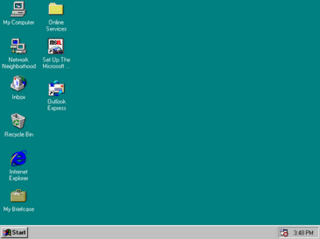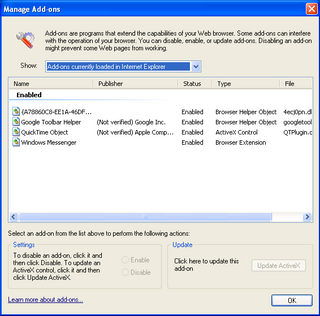
Windows XP is a major release of Microsoft's Windows NT operating system. It was released to manufacturing on August 24, 2001, and later to retail on October 25, 2001. It is a direct successor to Windows 2000 for high-end and business users and Windows Me for home users.
DLL hell is an umbrella term for the complications that arise when one works with dynamic-link libraries (DLLs) used with older Microsoft Windows operating systems, particularly legacy 16-bit editions, which all run in a single memory space. DLL hell can appear in many different ways, wherein affected programs may fail to run correctly, if at all. It is the Windows ecosystem-specific form of the general concept dependency hell.

Windows Update is a Microsoft service for the Windows 9x and Windows NT families of the Microsoft Windows operating system, which automates downloading and installing Microsoft Windows software updates over the Internet. The service delivers software updates for Windows, as well as the various Microsoft antivirus products, including Windows Defender and Microsoft Security Essentials. Since its inception, Microsoft has introduced two extensions of the service: Microsoft Update and Windows Update for Business. The former expands the core service to include other Microsoft products, such as Microsoft Office and Microsoft Expression Studio. The latter is available to business editions of Windows 10 and permits postponing updates or receiving updates only after they have undergone rigorous testing.

Windows 9x is a generic term referring to a line of discontinued Microsoft Windows operating systems from 1995 to 2000, which were based on the Windows 95 kernel and its underlying foundation of MS-DOS, both of which were updated in subsequent versions. The first version in the 9x series was Windows 95, which was succeeded by Windows 98 and then Windows Me, which was the third and last version of Windows on the 9x line, until the series was superseded by Windows XP.

In computing, a service pack comprises a collection of updates, fixes, or enhancements to a software program delivered in the form of a single installable package. Companies often release a service pack when the number of individual patches to a given program reaches a certain (arbitrary) limit, or the software release has shown to be stabilized with a limited number of remaining issues based on users' feedback and bug reports. In large software applications such as office suites, operating systems, database software, or network management, it is not uncommon to have a service pack issued within the first year or two of a product's release. Installing a service pack is easier and less error-prone than installing many individual patches, even more so when updating multiple computers over a network, where service packs are common.
A patch is data that is intended to be used to modify an existing software resource such as a program or a file, often to fix bugs and security vulnerabilities. A patch may be created to improve functionality, usability, or performance. A patch is typically provided by a vendor for updating the software that they provide. A patch may be created manually, but commonly it is created via a tool that compares two versions of the resource and generates data that can be used to transform one to the other.

Microsoft Windows XP Professional x64 Edition is an edition of Windows XP for x86-64 personal computers. It was released by Microsoft on April 25, 2005, around the same time as with the x86-64 versions of Windows Server 2003. It is designed to use the expanded 64-bit memory address space provided by the x86-64 architecture.

Windows NT 4.0 is a major release of the Windows NT operating system developed by Microsoft and oriented towards businesses. It is the direct successor to Windows NT 3.51, and was released to manufacturing on July 31, 1996, and then to retail in August 24, 1996, with the Server versions released to retail in September 1996.

A Browser Helper Object (BHO) is a DLL module designed as a plugin for the Microsoft Internet Explorer web browser to provide added functionality. BHOs were introduced in October 1997 with the release of version 4 of Internet Explorer. Most BHOs are loaded once by each new instance of Internet Explorer. However, in the case of Windows Explorer, a new instance is launched for each window.

Microsoft Office XP is an office suite which was officially revealed in July 2000 by Microsoft for the Windows operating system. Office XP was released to manufacturing on March 5, 2001, and was later made available to retail on May 31, 2001. A Mac OS X equivalent, Microsoft Office v. X was released on November 19, 2001.
Adobe Type Manager (ATM) was the name of a family of computer programs created and marketed by Adobe Systems for use with their PostScript Type 1 fonts. The last release was Adobe ATM Light 4.1.2, per Adobe's FTP.
AutoRun and the companion feature AutoPlay are components of the Microsoft Windows operating system that dictate what actions the system takes when a drive is mounted.

Windows Vista is a major release of the Windows NT operating system developed by Microsoft. It was the direct successor to Windows XP, released five years earlier, which was then the longest time span between successive releases of Microsoft Windows. It was released to manufacturing on November 8, 2006, and over the following two months, it was released in stages to business customers, original equipment manufacturers (OEMs), and retail channels. On January 30, 2007, it was released internationally and was made available for purchase and download from the Windows Marketplace; it is the first release of Windows to be made available through a digital distribution platform.
Microsoft Plus! is a discontinued commercial operating system enhancement product by Microsoft. The last edition is the Plus! SuperPack, which includes an assortment of screensavers, themes, and games, as well as multimedia applications. The Microsoft Plus! product was first announced on January 31, 1994, under the internal codename "Frosting". The first edition was an enhancement for Windows 95, Windows 95 Plus!
As the next version of Windows NT after Windows 2000, as well as the successor to Windows Me, Windows XP introduced many new features but it also removed some others.

Tweak UI is a free application, released in 1996 by Microsoft for customizing the Microsoft Windows operating system's user interface. Tweak UI modifies the Windows Registry in the same way as a user could edit it manually with a program such as RegEdit, but provides a simple graphical user interface that does not need knowledge of the registry structure, is quicker and easier to use, and not susceptible to registry damage due to user error.
Criticism of Windows XP deals with issues with security, performance and the presence of product activation errors that are specific to the Microsoft operating system Windows XP.

Software remastering is software development that recreates system software and applications while incorporating customizations, with the intent that it is copied and run elsewhere for "off-label" usage. The term comes from remastering in media production, where it is similarly distinguished from mere copying.
Windows XP, which is the next version of Windows NT after Windows 2000 and the successor to the consumer-oriented Windows Me, has been released in several editions since its original release in 2001.
The K-Lite Codec Pack is a collection of audio and video codecs for Microsoft Windows DirectShow that enables an operating system and its software to play various audio and video formats generally not supported by the operating system itself. The K-Lite Codec Pack also includes several related tools, including Media Player Classic Home Cinema (MPC-HC), Media Info Lite, and Codec Tweak Tool.











